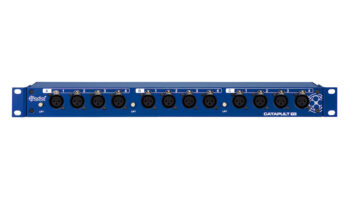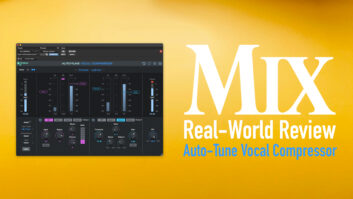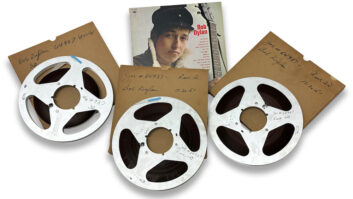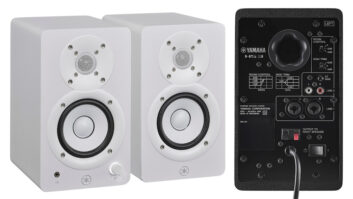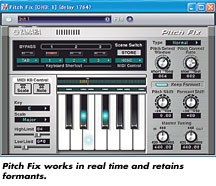
Workstation users, rejoice: A trio of new plug-ins brings Yamaha’sproprietary digital processing technology to your VST/AudioUnits-basedprojects. The Pitch Fix pitch-correction tool, Vocal Rack effectsprocessor for vocal tracks and the Final Master multibandcompressor/limiter mastering processor borrow DSP algorithms found inYamaha’s digital consoles and stand-alone effect processors. They alsosupport up to 24-bit/96kHz operation, dynamic automation of allpara-meters and snapshot settings recall.
PITCH FIX
I successfully installed all three plug-ins in my flat-panel iMac(Cubase SX 2, OS 10.3.2), Hewlett-Packard PC (Wavelab 4, XP Pro) and asuper PC (Nuendo, XP Pro) and they ran perfectly with minimum CPU drainand no differences in features, performance or sound quality from oneplatform/OS to another. (Plug-ins are Windows XP/2000/ME/98/98SE andMac OS 9.x/X-compatible.)
My immediate favorite was Pitch Fix, the first softwareimplementation of Yamaha’s formant/pitch correction and pitch-shiftingtechnology, as it offers simple real-time operation, ability to retainformants and good sound.
While Pitch Fix does not offer a Graphical mode, there are otherways to define its operation with the compact GUI. When instantiated,the plug-in defaults to automatic detection and correction. The Typebutton selects Normal (default), Male for low voices or Female forsoprano. Normal mode worked fine as a quick tune-up for a rough leadvocal on a demo song that needed backing singers. After those vocalswere recorded, I had the lead singer record a final vocal. I pulled afew difficult-to-pitch phrases from the tuned track and dropped theminto the new vocal take — they matched perfectly. I found withmost vocals, once I got the window and rate knobs tweaked, Normal modeworked well on the fly about 90 percent of the time.
For a few tough spots, I used an external MIDI controller or theonscreen octave keyboard to “play” target pitches. You canplay a scale of target pitches here or click on a customized set ofacceptable pitches above each keyboard key. The high/low limit fadersset the maximum operating pitch range and increase pitch changeaccuracy. The onscreen keyboard lights with every corrected pitch, anda linear tuning meter reads incoming pitch and deviation from truepitch, which is defined as concert, or A = 440 Hz. There are controlsto change this if you need to re-reference the plug-in. There are alsochoices of song key, major or minor scales, or chromatic (everyhalf-step) to automatically set the universe of acceptable targetpitches.
Pitch Fix’s biggest feature is that, by default, it uses formantshifting to preserve the original signal’s quality without creatingartifacts or distortion. If Keep Formants is set to Off, then formantsraise and lower with the pitch. Moving formants up or down producesstrange vocal affectations that are still in pitch even though theysound cross-gender.
If you use several different Pitch Fix setups throughout a song, youcan store snapshots (called Scenes) and recall them using keyboardshortcuts chosen from a drop-down menu. This feature is good for songsthat change scales or modulate to new keys.
VOCAL RACK
Vocal Rack comprises six main vocal processors and 20 factorypresets. The eight processing stages include highpass filter, phaseflip, compressor, harmonic enhancer, 3-band parametric EQ, de-esser,gate and delay. The 20 presets are good starting points — similarto tutorials on vocal chain processing for novices — though mostare set over the top. Also good for students is the classic audiotextbook input vs. output transfer function graph, where you can seethreshold, ratio and output control fader changes. The Auto modeautomatically re-adjusts the output level as threshold is changed— a nice feature. I liked the sound of the compressor, though Ifound it a bit fiddly when making subtle adjustments. Unfortunately,only Pitch Fix lets you click on a parameter box and type in avalue.
The graphical 3-band EQ does not let you grab a point on the graphand drag it, but rather you must first select one of the three bandsand then click-and-drag only that band. Control+click changes the Q ofthe midrange band from 1 up to 12. All three bands generously overlapand boost or cut up to 12 dB. I found that they worked well for anyinstrument track or vocals.
The de-esser has just threshold and frequency controls, but does thejob well, even on vocals with hard-to-detect ‘ess’problems. A Monitor feature lets you listen to the band of frequenciesbeing reduced. Both the compressor and de-esser have non-calibratedgain reduction meters that only intermittently work — difficultto make fine adjustments. This was true even on the 2.4GHz P4 systemrunning Nuendo.
Although noise gates are not normally needed for vocal processing,this section worked fine for suppressing headphone leakage. I found thesame thing with the harmonic enhancer (a brightener that works inmoderation on extremely dull sources) and delay (which only goes to 50ms and has no feedback or LP filter controls, limiting you to a simplemono doubling effect) sections.
FINAL MASTER

Final Master is a stereo 3-band compressor/limiter with adjustablefrequency control, three soft clipping models and look-aheadtechnology, as well as two adjustable crossover points: one between thelow and mid-band and the other between the high and mid-bands.Multiband compression works well to get a tight and compressed low end,yet retains a transparent midrange and high-end openness. This plug-inreminds me a little of the 3-band compressor in the TC ElectronicFinalizer, although I’d use the Finalizer if I wanted a more brutalsound.
Final Master was perfect for an acoustic guitar and bass-only trackrecorded live to DAT. After transferring to Cubase SX 2 and without anyway to remix, I was able to jump the level up and re-balance the twoinstruments for a more listenable final result. I soloed or bypassed tocheck any combination of the three bands for quality. I also liked theimmediate change that the overall mix’s sonic signature took whensliding the crossover points up and down. Each band has a complete setof compressor controls and gain-reduction meter. Once you are close tothe sound that you want, click Link and move all similar controlstogether while keeping their relative positions intact. You can Unlinkand change something in one of the bands and then go back to Link toproportionately change them.
Like Vocal Rack, Final Master’s Auto mode adjusts all three bands’output level together relative to threshold. Look Ahead sets the delayof all three outputs together so that the detecting algorithm has time— important for very fast attack time settings and running theplug-in on a slower computer. There are also three choices ofsoft-limit clip curves that suppress excessive peaks in the overallaudio.
A GOOD COLLECTION
Great for the beginner to the seasoned audio pro, these plug-insmake for a good starting collection from Yamaha with their ease of useand great sound. I found Vocal Rack and Final Master to be good tools,although a bit pricey. On the other hand, Pitch Fix is as good, orbetter, than other pitch-change plug-ins that cost much more.
MSRPs: Pitch Fix, $299; Vocal Rack, $199; and Final Master,$199.
Yamaha Corporation of America, 714/522-9011, www.yamaha.com/dmi.
Barry Rudolph (www.barryrudolph.com) is an L.A.-based recordingengineer.

